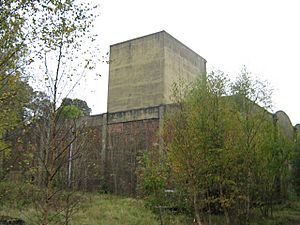M. S. Factory, Valley facts for kids
The M.S. (Ministry of Supply) Factory, Valley was a secret site in Rhydymwyn, Flintshire, Wales. During World War II, it was used to store and make mustard gas, a type of chemical weapon. Later, it helped develop the UK's atomic bomb. More recently, it stored emergency supplies like food.
Contents
History of the Valley Site
This site covers about 35 hectares (that's like 86 football fields!) in the Alyn Valley. It's south of Rhydymwyn village. Long ago, people mined lead here. In 1939, the Ministry of Supply bought the land. They built a special factory and storage place for chemical weapons.
Over 100 buildings were built. They were connected by a railway line. Workers also changed the River Alyn and dug secret tunnels underground. During World War II, the factory made weapons with mustard gas. It also helped with the atomic bomb project. After the war, it stored German nerve gas. In the 1950s, Britain stopped making chemical weapons. The site then stopped being a chemical storage facility. However, it is still watched as a chemical weapons site.
From the 1960s, the site stored emergency food and supplies. It also had mobile bakeries. In 1994, the site closed down. Many buildings were taken apart. But some important buildings still stand. They remind us of a huge building effort that changed Britain.
Making Chemical Weapons
In the late 1930s, the British government worried about Germany using mustard gas. They wanted to be ready to fight back. So, in 1939, the Alyn Valley was chosen for a new factory. The Ministry of Supply and Imperial Chemical Industries (ICI) managed the project.
Work started in October 1939. They began digging storage tunnels in the limestone hillside. The factory, called M.S. Factory, Valley, opened in 1941. It was meant to produce different types of mustard gas. Records show they mainly made a purer, more stable type.
From 1940 to 1959, the site made, put together, or stored chemical weapons. After 1947, most of Britain's mustard gas was kept in the tunnels. This site is very important because it's the only one of its kind left in the UK. It shows how chemical weapons were made and stored.
Helping with Nuclear Weapons
In 1941, the government wanted to know if an atomic bomb could be built. They needed to check if a special process called "gaseous diffusion" would work. This process helps get enough material for an atomic bomb.
One of the buildings at Valley (P6) was used for testing in 1942. This was part of the secret 'Tube Alloys' project. This project later moved to America and became the Manhattan Project. Four test machines were put in Building P6. They tested how to separate uranium. Experiments continued until 1945. The results helped build a large factory in Capenhurst, Cheshire. Building P6 is now a special listed building and is important worldwide. For a short time, it was at the forefront of nuclear science.
Cold War Storage Site
During the Cold War, Britain remembered the U-boat attacks in both world wars. These attacks stopped food from reaching the country. Also, cities were bombed in World War II. So, the government decided to store food and materials. This was to prepare for a possible nuclear war. The M.S. Factory, Valley, became one of these storage sites. It held large amounts of emergency supplies.
After the Cold War
The Valley Works site is now a nature reserve. It has become home to many different animals and plants. A plaque at the entrance tells visitors about it.
Tunnels Open to the Public
On April 22, 2017, the Rhydymwyn Tunnels officially opened. Ken Skates, a Welsh government official, opened them. Now, people can visit the tunnels with guided tours.
Key Facts About the Site
- The government first approved £546,000 for the site.
- By 1943, about 2,200 people worked at Valley. Most were sent there by the government. They lived with local families.
- During the war, 5.2 million weapons were made here. Many were smoke generators used from D-Day onwards.
- The factory cost about £3.2 million in total.
- The site covers 86.8 acres (351,260 square meters). It has 7 miles (11 km) of secure fences. It was always a "Secret" site.
The Rhydymwyn Valley Nature Reserve
The M.S. Factory, Valley, hasn't been used since the mid-1990s. Before that, many buildings were used for storing emergency supplies. Some were taken down because they were unsafe. Now, the site is a Nature Reserve. A Visitor Centre was built where the old gatehouse used to be.
The site covers 86 acres (348,000 square meters). It's in a U-shaped valley south of the village. Long ago, there were lead mines and a metal foundry here. The western side has old woodland. You can find wild garlic, snowdrops, bluebells, and orchids there. The River Alyn flows into the site from the north-west. It used to wind through the middle of the valley. But it was moved and straightened with concrete sides during construction. Parts of the river now flow underground. The site is now home to 7 types of reptiles and amphibians. It also has 8 types of fish, 17 types of butterfly/moth, and 8 types of bat. About 67 different bird species have nested or been seen here.



